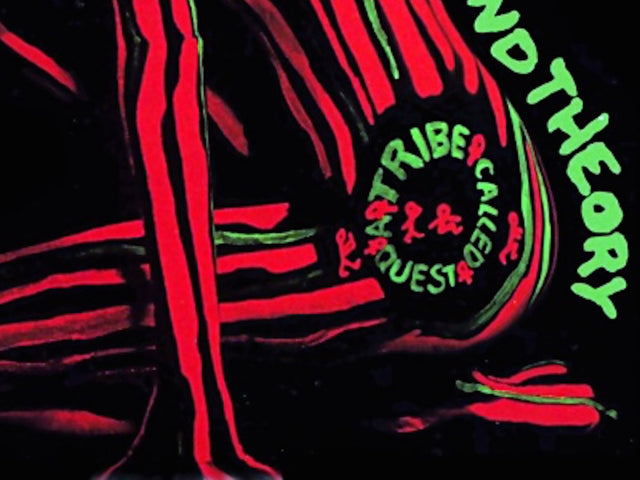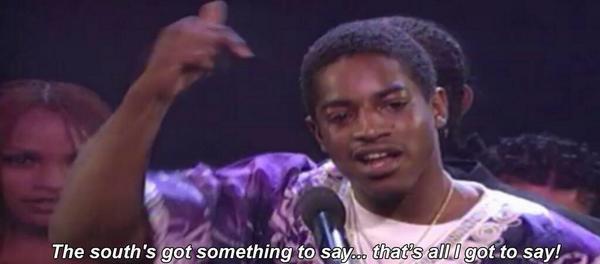Saya Harap Anda Terbangun: Boogie Down Productions' 'Criminal Minded' di 30
A Rap Classic Turns 30
I. 9mm Goes Bang
Pada 30 Mei 1988, New York Times mengangkat sebuah item Associated Press yang berjudul “2 Pemuda Ditangkap dalam Pembunuhan Disc Jockey.” Ini adalah saat ketika gaya Times adalah teen-ager alih-alih teenager. NYPD menangkap Kendall Newland, seorang remaja berusia 18 tahun dari Bronx, dan menuduhnya melakukan pembunuhan derajat kedua atas kematian Scott Sterling, yang terjadi hampir sembilan bulan sebelumnya, di University Ave, di seberang proyek High Bridge Homes, jalan raya, stasiun kereta, Sungai Harlem. Pemuda lainnya yang dituduh adalah Cory Bayne, 17, yang sudah ditahan setelah dituduh mencuri token subway dari pintu putar.
Scott Sterling adalah Scott La Rock, DJ yang, bersama KRS-One, membentuk tulang punggung Boogie Down Productions. Mereka bertemu ketika Scott bekerja sebagai pekerja sosial di Penampungan Pria Franklin Armory di 166th St., dan Kris—dia hanya Kris—mengklaim wawancara kerja palsu untuk mendapatkan stok token subway yang disediakan Armory untuk membantu penghuni mencari pekerjaan. Scott dan Kris terlibat pertengkaran; Kris menyebut Scott “Negro rumah.” Mereka harus dipisahkan oleh keamanan.
Itu sekitar tahun 1985. Sejarah dari titik itu cukup terdokumentasi dengan baik: Scott mulai membawa Kris yang masih tunawisma, bersama tiga pemuda lainnya (termasuk D-Nice, yang baru berusia 15 tahun), 20 blok ke selatan untuk menonton dia DJ di Broadway Repertoire Theatre. Tak lama kemudian, Scott dan Kris mulai membuat lagu mereka sendiri dan memanfaatkan Rock Candy Records untuk memberi mereka label rekaman anak perusahaan mereka sendiri. Mereka membuat beberapa demo, namun Mr. Magic menolaknya, dan mereka mengambil penolakan Mr. Magic sebagai tembakan peringatan dari Queens itu sendiri. Dengan bantuan Ced Gee (pendiri Ultramagnetic MC—baik Scott maupun Kris telah berlatih menggunakan peralatannya), mereka merilis Criminal Minded, yang keluar pada Maret 1987. Ini sukses cepat, sehingga Warner Bros. mengindikasikan bahwa mereka ingin menyelamatkan BDP dari kesepakatan Rock Candy yang cepat menjadi pahit.
Tetapi Scott tidak akan hidup untuk menandatangani kesepakatan Warner. Pada 26 Agustus, dia pergi dengan rombongan orang ke High Bridge untuk bernegosiasi setelah D-Nice dipukuli karena terlibat dengan pacar seorang pria muda lainnya. Intervensi yang direncanakan itu menjadi kekerasan: saat La Rock dan seorang pengawal berjalan kembali ke Jeep merah mereka yang bisa dibuka atap setelah berbicara dengan teman-teman penyiksa D-Nice, tembakan mulai bersenandung. La Rock terkena dua peluru, satu di belakang telinganya dan satu di lehernya.
Dia dibawa ke Rumah Sakit Lincoln Memorial tepat setelah pukul 11 malam. Pada pukul 5 sore keesokan harinya, ibunya mencabut alat bantu hidupnya. MC Serch, yang tiba di rumah sakit sekitar tengah malam, memberi tahu XXL bahwa KRS sedang mondar-mandir di lorong, berkata “Kita harus terus maju.”
II. Biaya Narkoba
Sebelum kita melanjutkan, saya harus mengungkapkan beberapa hal. Saya lahir pada tahun 1992, dan tidak bisa berbicara dengan otoritas mengenai seperti apa Bronx Selatan pada tahun 1987, atau seberapa sering Red Alert memutar lagu-lagu dari Criminal Minded, atau bagaimana rasanya bagi Shan untuk dipanggil, atau apakah saya akan secara refleks berpihak pada Marley Marl (saya pasti akan). Saya tidak ada di sana. Album rap besar pertama yang bisa saya berikan konteks yang bermakna adalah Get Rich or Die Trying. Pertama kali saya melihat KRS-One adalah di DVD Beef yang dicuri teman saya dari kakak tirinya. Ketika saya mendengar melodi “Children’s Story” saya memikirkan Mos Def dan Puff sebelum otak saya beralih ke Slick Rick. Dan pertama kali saya mendengar sampel Zungguzungguguzungguzeng di “Remix for P is Free,” saya berpikir, “Oh, Definition.”
Selain itu, dan tanpa berlebihan, saya akan mengatakan bahwa semua penelitian, jika bisa disebut demikian, yang saya lakukan saat masih kecil sebenarnya adalah mendengarkan dan membaca banyak sekali cerita dari tahun Reagan di internet dial-up. Jadi tidak ada laporan asli di sini. Di sisi lain, ini bukan artikel di mana seorang penulis “melihat Criminal Minded melalui lensa tahun 2017” atau (semoga tidak) mencoba menarik hubungan antara MCA dan Gedung Putih Trump atau sejenisnya.
Tetapi penting, atau setidaknya menarik, untuk melihat ke belakang dan melihat bagaimana catatan pembentuk genre menavigasi sejarah itu sendiri. Dan jadi “Remix” adalah semacam biografi kapsul: Kris melangkah keluar dari orbit tempat pembuangan crack, memasukkan potongan-potongan Jamaica, dari dirinya sendiri. Yellowman ada di sana, begitu juga seorang pecandu di 116th St.
Dan sebenarnya, Criminal Minded diciptakan sebagai pertarungan atas sejarah. Bahkan jika anggukan bahu Mr. Magic adalah pemicu, mesin BDP bergerak untuk merespons “The Bridge,” yang N.B.- diabaikan di sebagian besar sejarah rap demi lagu-lagu inferior dari era tersebut. “South Bronx” kurang berani secara musik dibandingkan “The Bridge,” tetapi dua kali lebih kejam: lihat tembakan pada kesepakatan label buruk Shan, atau “Alih-alih mencoba mengalahkan LL/ Kamu perlu mengeluarkan teman-temanmu dari narkoba.” KRS menambahkan bahwa dia tidak pernah mendengar “suara” dari Queens dari tahun ‘76 hingga ‘80, dan bahwa siapa pun yang mengklaim sebaliknya di Bronx, yah, tidak akan hidup.
Jadi, tanpa terjebak terlalu dalam di sini, Shan merespons dengan “Kill That Noise,” yang memunculkan “The Bridge is Over.” (Seperti Criminal Minded, Down By Law milik Shan memiliki dua lagu dari kontra mereka. BDP membagi “South Bronx” dan “The Bridge is Over” di album mereka, tetapi Shan memilih untuk menempatkan “Kill That Noise” langsung setelah “The Bridge” di albumnya.) “The Bridge is Over” adalah momen penting bagi La Rock dan—terutama—bagi KRS, yang menjadikannya sangat Jamaika dengan cara yang menonjolkan perpecahan budaya borough. Lebih lanjut: dia menulis rima terbaik dalam hidupnya sampai saat itu, dan untuk pertama kalinya tampak seperti teman sejati dari Juice Crew.
Selama bertahun-tahun setelah semua ini terjadi, Shan mempertahankan bahwa “The Bridge” hanya tentang bagaimana hip-hop di Queensbridge dimulai, bukan bagaimana hip-hop (dalam arti global) dimulai di Queensbridge. Itu tidak masalah. Dalam beberapa bulan, KRS telah membungkus dirinya dalam leksikon Bronx, dan semantik tidak sebanding dengan “Manhattan keeps on making it…” Ini adalah perang suci, dan Kris menggambar garis pertempuran di gelombang radio dan udara tipis.
III. Saya Harap Anda Terbangun
Di “Elementary,” Kris mengeja KRS-One: pengetahuan menguasai hampir semua orang. Dia juga membawa enam botol Heineken, “Saya menjadi mabuk.” Selama tahun Clinton dan W. Bush, dia memasuki peran profesor, membagikan kebijaksanaan dan (lebih sering, terlalu sering) menegur mereka yang mengikutinya ke dalam rekaman. Ingat perseteruan dengan Nelly?
Tetapi bukankah agak menginspirasi untuk melihat ke belakang dan menyadari bahwa KRS selalu KRS? Bahwa Kris tidak secara perlahan mengumpulkan pengetahuan dan pengalaman hidup sampai dia merasa layak atas gelar tersebut—bahwa dia membangunnya dari nol, memutuskan dia adalah seorang guru dan menjadikannya demikian?
Sulit untuk mendengarkan Criminal Minded tanpa membayangkan di mana Scott La Rock mungkin sekarang—dan tanpa menyadari kemiripan yang menakutkan antara pembunuhannya dan hipotesis yang tercantum di “9mm.” Dan ada bagian (“Puisi,” sampel AC/DC di “Dope Beat,” yang sangat gila “Super Hoe,” di mana KRS menyombongkan diri tentang kekuatan ereksi Scott) yang tidak sama sekali relevan saat ini. Tetapi pada tingkat formal, ini adalah salah satu pencapaian tertinggi rap, bukan hanya sebuah tonggak yang mengukur kemajuan dan menandai lambatnya perjalanan waktu.
Criminal Minded layak didengarkan berulang kali di tahun 2017, dan bukan untuk mental memecahnya menjadi bagian-bagian dan melacak lagu-lagu mana yang digunakan kembali oleh para rapper yang datang kemudian—meskipun itu adalah apa yang tampaknya KRS sendiri anjurkan di lagu penutup yang bertitel:
“Saya bukan maniak musik atau penggemar b-boy
Saya hanya memanfaatkan apa yang ada di atas di loteng
Saya mendengarkan MC ini saat saya masih kecil
tetapi saya menembakkan lebih banyak tembakan daripada yang pernah mereka lakukan.”
Criminal Minded adalah snapshot yang ditangguhkan dalam amber dari tahun 1986 dan ‘87, tentang Scott yang mempelajari kebiasaan peralatannya dan Kris yang menyelesaikan kekurangan dalam gayanya, tentang D-Nice yang mendedikasikan masa remajanya untuk menyempurnakan seperangkat keterampilan yang sangat sempit. Ingatlah bahwa sepenuhnya dua puluh persen dari album ini didedikasikan untuk perseteruan bolak-balik tanpa ada skit atau interlude untuk memberikan konteks: ini dibuat dengan napas yang cepat, bukan dengan memikirkan bagaimana bunyinya dalam tiga puluh tahun. Dan dengan melakukannya, BDP membuat sesuatu yang tidak akan pudar tidak peduli seberapa lama ia dibiarkan di elemen. Lihat, raja kehilangan mahkota, tetapi guru tetap cerdas.
Paul Thompson is a Canadian writer and critic who lives in Los Angeles. His work has appeared in GQ, Rolling Stone, New York Magazine and Playboy, among other outlets.



